Hello LSC.
We’d like to take some time to talk about Eurasian watermilfoil (milfoil, EWM, Myriophyllum spicatum) - what it is, what it does when introduced into a lake, and why we work to control it in Lake St. Catherine. We’ll also detail our Milfoil Control Program for the 2022 season.
> What is milfoil?
Eurasian watermilfoil is not native to North America but originates from Europe, Asia and northern Africa. As an aquatic invasive species (AIS) to this continent, Eurasian watermilfoil has no natural controls (insects, bacteria, fungi) to keep its growth in check. Milfoil stems can reach the surface in up to 20 feet of water, growing up from the lake bottom each year from a fibrous root system. Milfoil grows and spreads extremely quickly, forming dense surface mats.
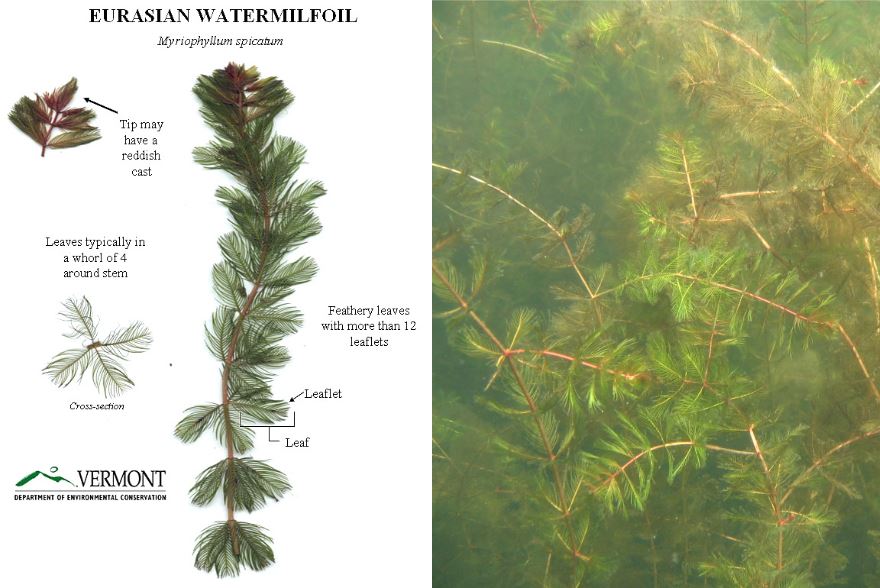
Milfoil reproduces by the breaking off of fragments which can drift away, sink, develop roots, and grow into plants. A fragment just a few inches long is capable of starting a new plant. This fragmentation occurs both naturally and as a result of human activity. Within a lake, wind and waves may break plants loose, allowing them to drift into new locations and root. Boating activity through milfoil beds also contributes to the fragmenting and spread of milfoil plants.
Milfoil was introduced into Lake St. Catherine in the early 1970s, and it quickly spread around the lake. With milfoil increasingly becoming an issue, in 1979, the LSCA purchased a mechanical harvesting machine (many lake old-timers will remember “Hungry Harvey”). This was the only form of milfoil “control” at the time. After many years of using harvesting machines, it was determined that the cutting of the milfoil was actually contributing to its spread around the lake because of the fragmentation created, and other control options were explored.
> What impact does milfoil have on a lake, and why does it need to be controlled?
From USGS.gov:
“Eurasian water-milfoil competes aggressively to displace and reduce the diversity of native aquatic plants. It elongates from shoots initiated in the fall, beginning spring growth earlier than other aquatic plants. Tolerant of low water temperatures, it quickly grows to the surface, forming dense canopies that overtop and shade the surrounding vegetation (Madsen et al. 1991). Canopy formation and light reduction, are significant factors in the decline of native plant abundance and diversity observed when Eurasian water-milfoil invades healthy plant communities (Smith and Barko 1990; Madsen 1994).”
From the Lake Champlain Basin Program (LCBP), milfoil can:
- Decrease native plant diversity by out-competing native aquatic plants
- Decrease light penetration, habitat complexity and oxygenation
- Increase sedimentation, nutrient loading, and accelerate eutrophication
- Affect PH and temperature levels
When milfoil was introduced into Lake St. Catherine, it quickly spread throughout the littoral zone of the lake (the area of the lake that supports rooted aquatic vegetation), out-competing our native plants, and impacting the health of the lake.
Here are some images from Little Lake taken in early June of last year. Because of its shallow depth, the whole of Little Lake is a littoral zone. You can see how dense the milfoil can grow, and how it had taken over Little Lake:
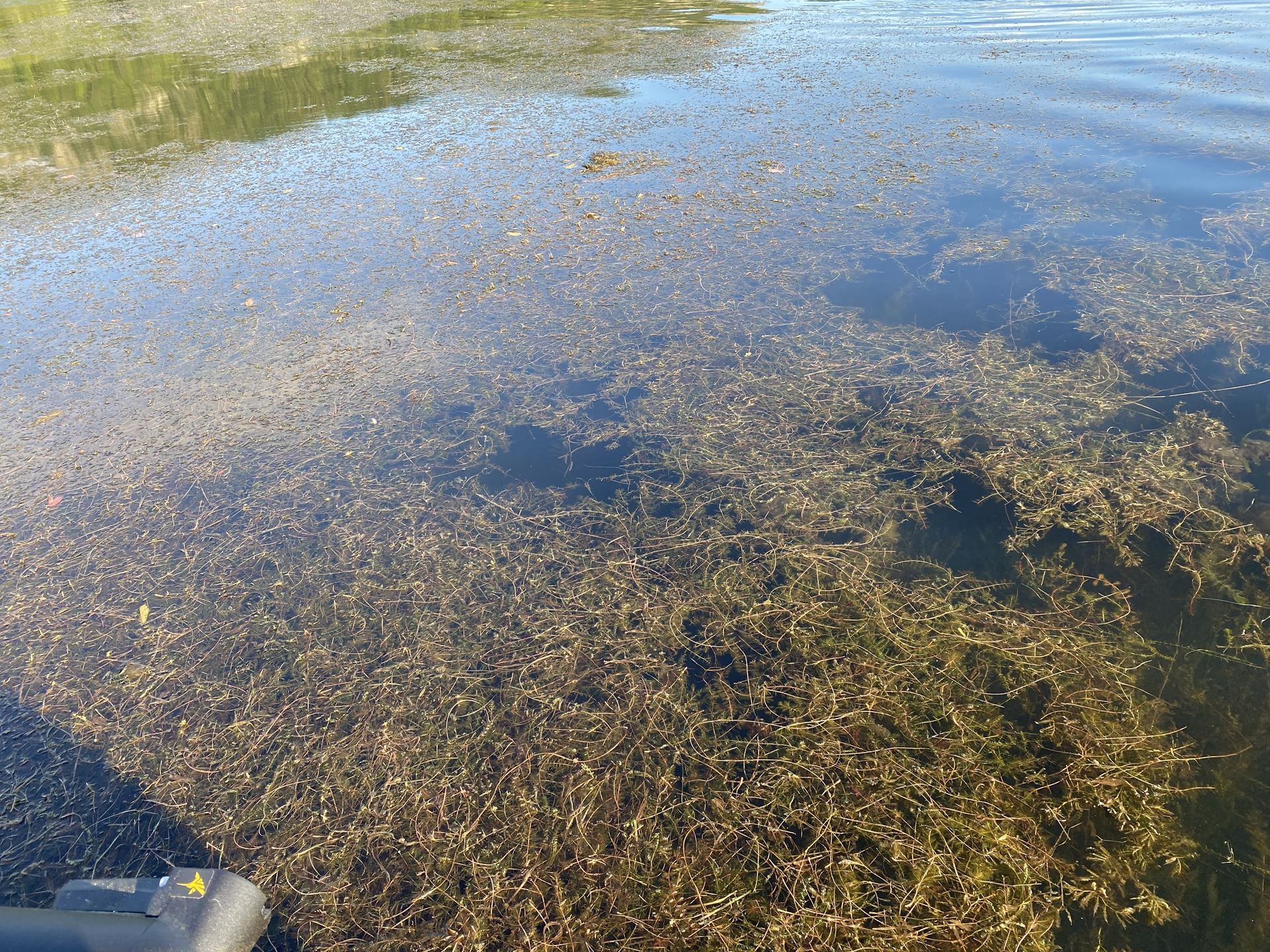
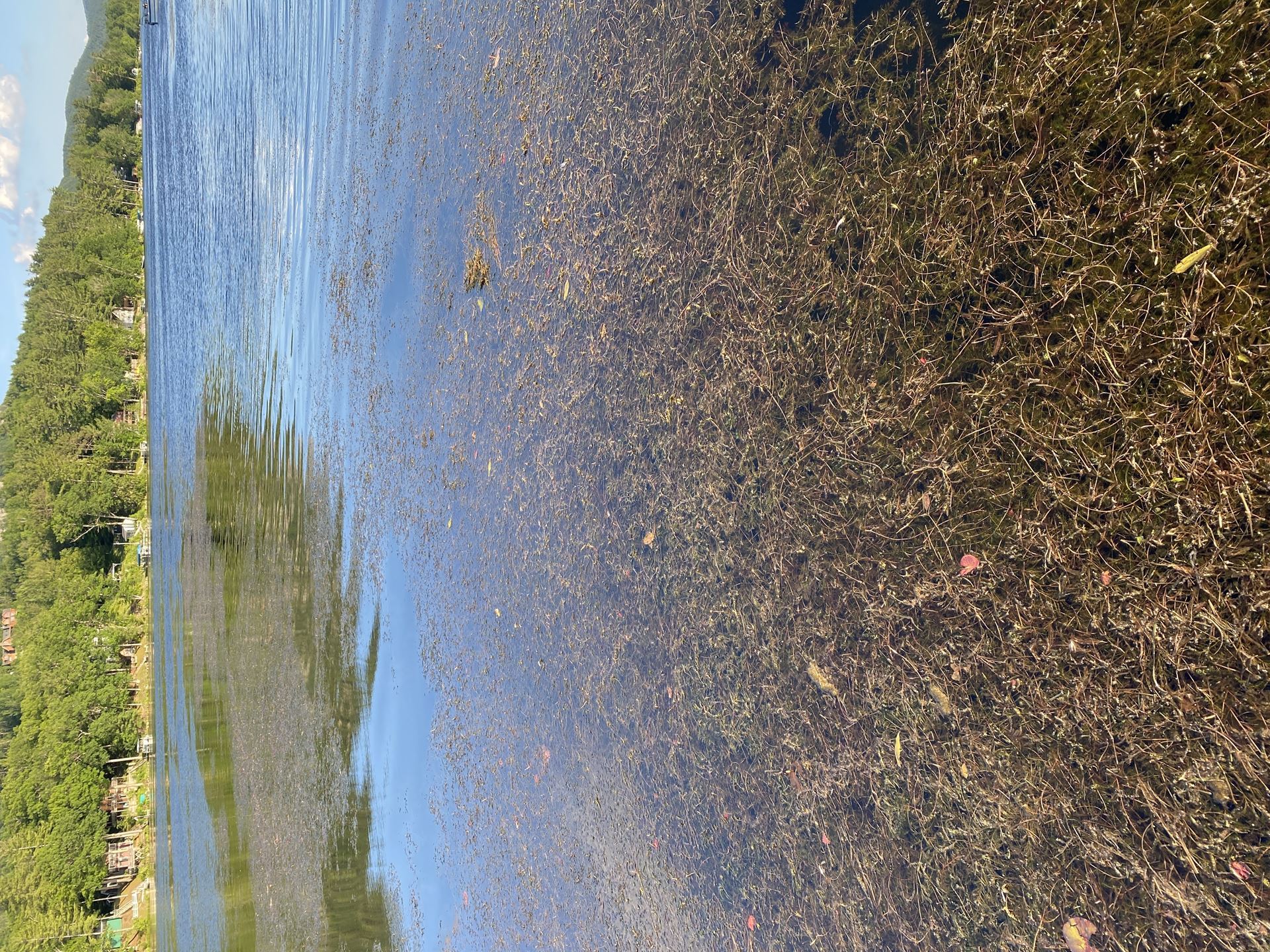
> What does the Lake St. Catherine Association do to control milfoil?
The LSCA’s Milfoil Control Program consists of four components:
- ‘Stop The Spread’ education and outreach. Our ‘Stop The Spread’ campaign educates boaters and property owners on best practices to limit the spread of milfoil.
- Volunteer milfoil cleanup. Throughout the season, we organize volunteers to collect floating milfoil from the lake and deposit it at designated drop off points. The milfoil is then picked up from the points and disposed of. We also encourage boaters and property owners to remove any milfoil they see in the lake.
- DASH - Diver Assisted Suction Harvesting. Our DASH crew hand-pulls milfoil by the roots from the lakebed which is then suctioned up through a tube to a catch table on a boat. Milfoil is then placed in 17.5 gallon buckets for transport.
- Herbicide spot treatments with ProcellaCOR EC. In order to maximize our DASH crew’s time, effectiveness, and amount of acres covered, one of our control methods includes spot treatments of the herbicide ProcellaCOR EC.
These efforts have resulted in the lowest percent of milfoil cover and frequency of occurrence at our 199 GPS data points in the lake since the mid-2000s. Also, and just as importantly, we have seen many species of our native aquatic plants like Water stargrass, Tape grass, Thin-leaf pondweed, Illinois pondweed, Common waterweed, and Robbins’ pondweed have all increased in frequency of occurrence at the data points.
This is exactly what we want to see!
Lake St. Catherine has over 30 native aquatic plants which are important and necessary to sustain a healthy lake ecology. Our efforts are focused on reducing the amount of milfoil in the lake so that these native aquatic plants can grow as they normally would. Keeping milfoil under control is helping to return the aquatic plant environment to conditions before milfoil was introduced in the 1970s. Because of our milfoil control efforts, we again have a complex and diverse native plant community.
It’s also important to note that our Boat Launch Greeter Program is a crucial part of invasive species prevention. Although we already have milfoil in Lake St. Catherine, other Vermont lakes do not. Our Greeters who are on duty at the Boat Launch in Wells, and the State Park in Poultney, check the boats and trailers to make sure they do not have milfoil on them when they leave. They also check boats and trailers entering the lake for other invasive species like zebra mussels, spiny waterflea, asian clams, and water chestnut which are only a lake away from LSC.
> What specifically will the Lake St. Catherine Association do this year to control milfoil?
We’ll start off the season with our educational “Stop The Spread” campaign, including some best practices specifically for Little Lake.
This is a list of our best practices to top the spread of milfoil:
- As a general rule, get as much milfoil out of the lake as possible. Let it dry out on land and dispose of it as you would yard waste.
- Don’t drive through milfoil patches with your boat which will create fragments.
- If you have milfoil on your prop, don’t just reverse and drive away, please remove it from the lake.
- If you have milfoil growing in your dock or swimming area, pull it out by the roots and remove it from the lake.
- If you see milfoil floating anywhere in the lake, near your dock, or along your shoreline, remove it from the lake.
- Obey boating regulations by traveling at no-wake, 5 MPH speeds within 200’ of the shoreline.
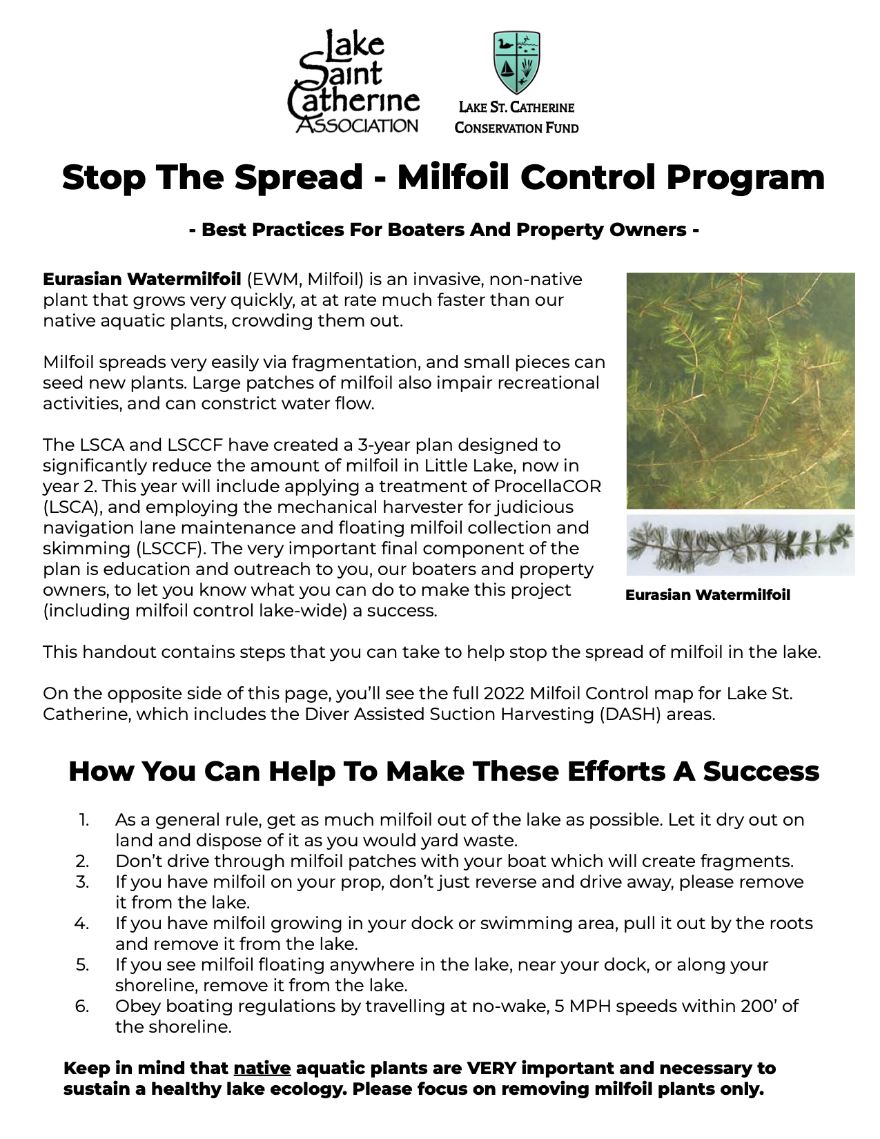
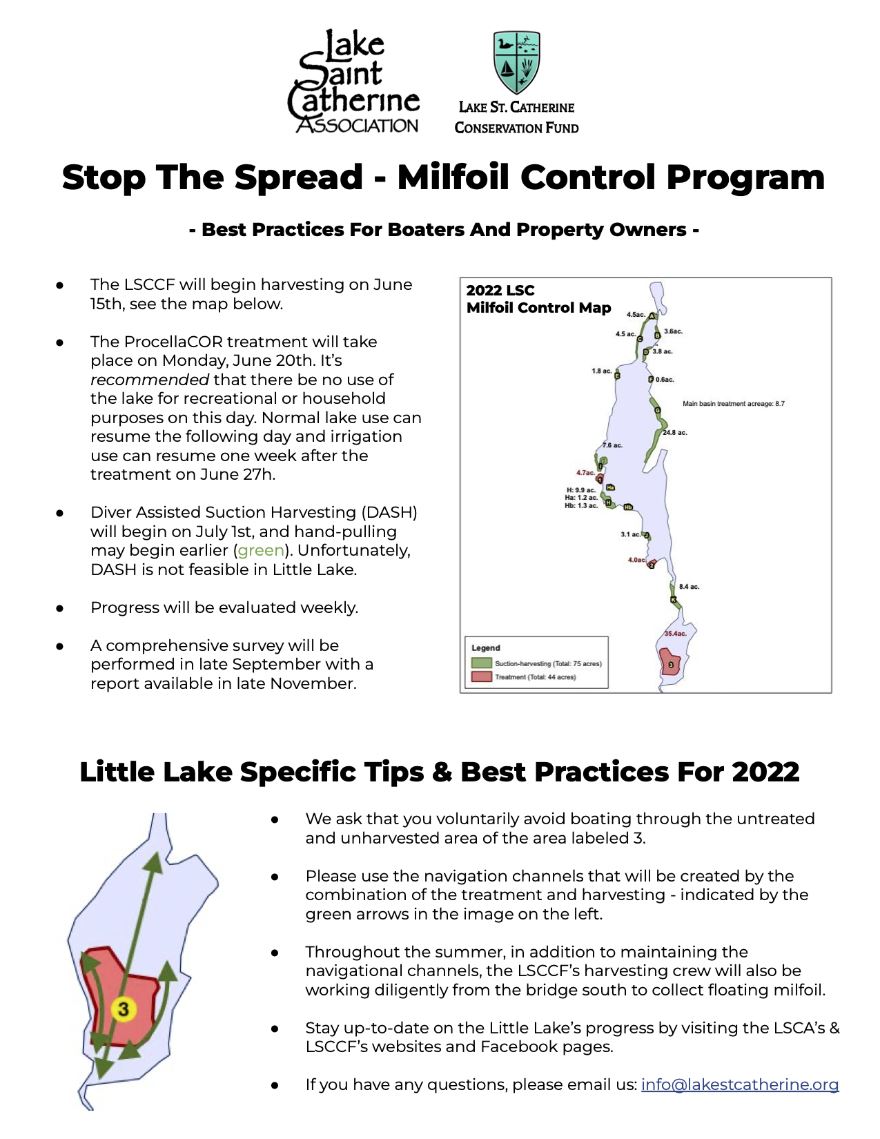
On Sunday, June 5th at the Wells Lakeside Park, the LSCA and LSCCF will have our Milfoil Cleanup Community Day kickoff. We’ll get together to talk about the Milfoil Control Program, and then head out on the lake and get to work. We’ll all head out onto the lake in kayaks, boats, canoes, and SUPs to scoop up floating milfoil and other detached plants and place them on the drop off float that will be set up in the Channel south of the bridge. At the end of the day, we’ll collect the milfoil from the float and dispose of it. The drop off float will stay in place after the Clean Up Day kickoff so volunteers can continue to remove milfoil from the lake for the rest of the season.
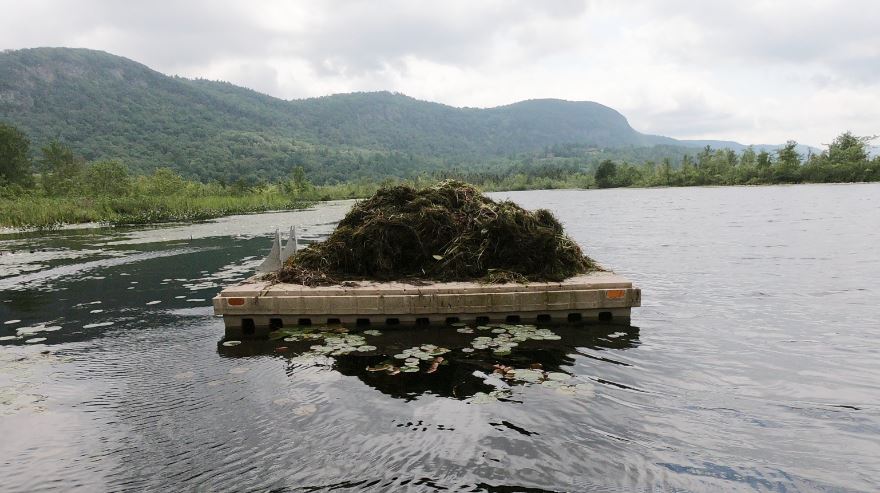
Next, on Monday, June 20th, 3 areas on the lake will be treated with ProcellaCOR EC. Please see the advisory:
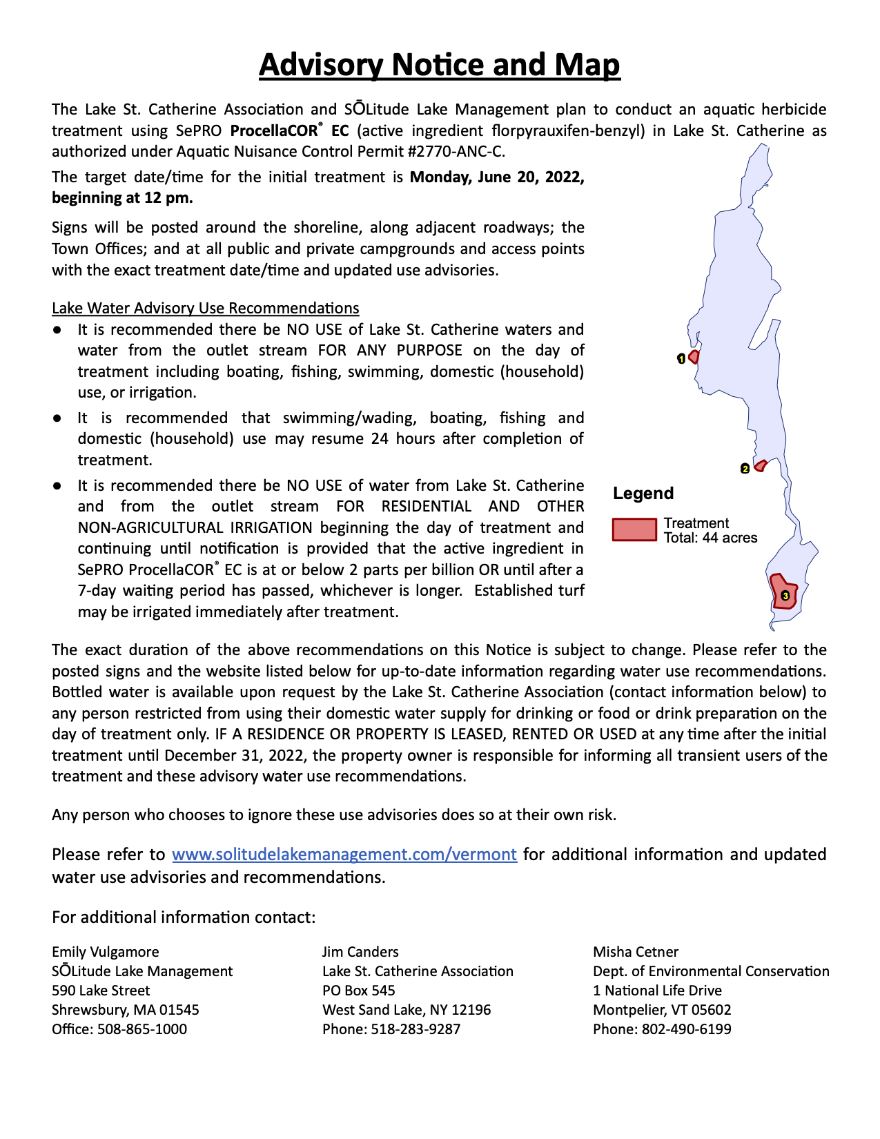
On May 16th, biologists from SOLitude Lake Management and a member of our DASH team performed a milfoil survey. A comprehensive two day aquatic plant survey had been previously performed in late September 2021. Areas to be treated with ProcellaCOR and areas to be addressed with DASH have been identified, and a map showing these locations is attached below. There will be 3 spot treatments of ProcellaCOR totaling approximately 44 acres.
During and after the treatment, please be aware of the following lake water use restriction recommendations:
- No use of Lake St. Catherine waters and water from the outlet stream FOR ANY PURPOSE including boating, fishing, swimming, domestic (household) use or irrigation, the day of treatment on:
Monday, June 20, 2022, beginning at 12 PM
- Swimming/wading, boating, fishing and domestic (household) use may resume on:
Tuesday, June 21, 2022, beginning at 12 PM
- USE of water from Lake St. Catherine FOR IRRIGATION PURPOSES including for watering lawns, trees, or other plants may resume on:
Monday, June 27, 2022, beginning at 12 PM or earlier based on sampling results
Links:
- LSCA Permit Application
- Draft Permit
- SePRO ProcellaCOR® EC Specimen Label
- SePRO ProcellaCOR® EC Safety Data Sheet
The treatment will be funded by the remaining funds from last year’s fundraiser, and an equal contribution from the LSCA and LSCCF.
Then, beginning on July 1st, our DASH team will begin hand pulling milfoil by the roots from the lakebed and using a suction tube to deposit the milfoil into a catch basin on their boat for removal from the lake. Our DASH team will work throughout the summer at 11 locations totaling approximately 75 acres.
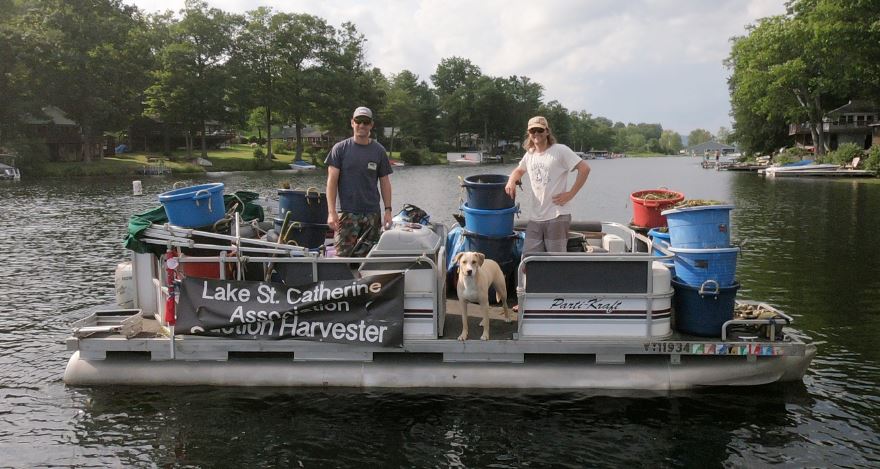
Here is the full management map for 2022 showing our DASH areas (green) and the spot treatment areas (red):
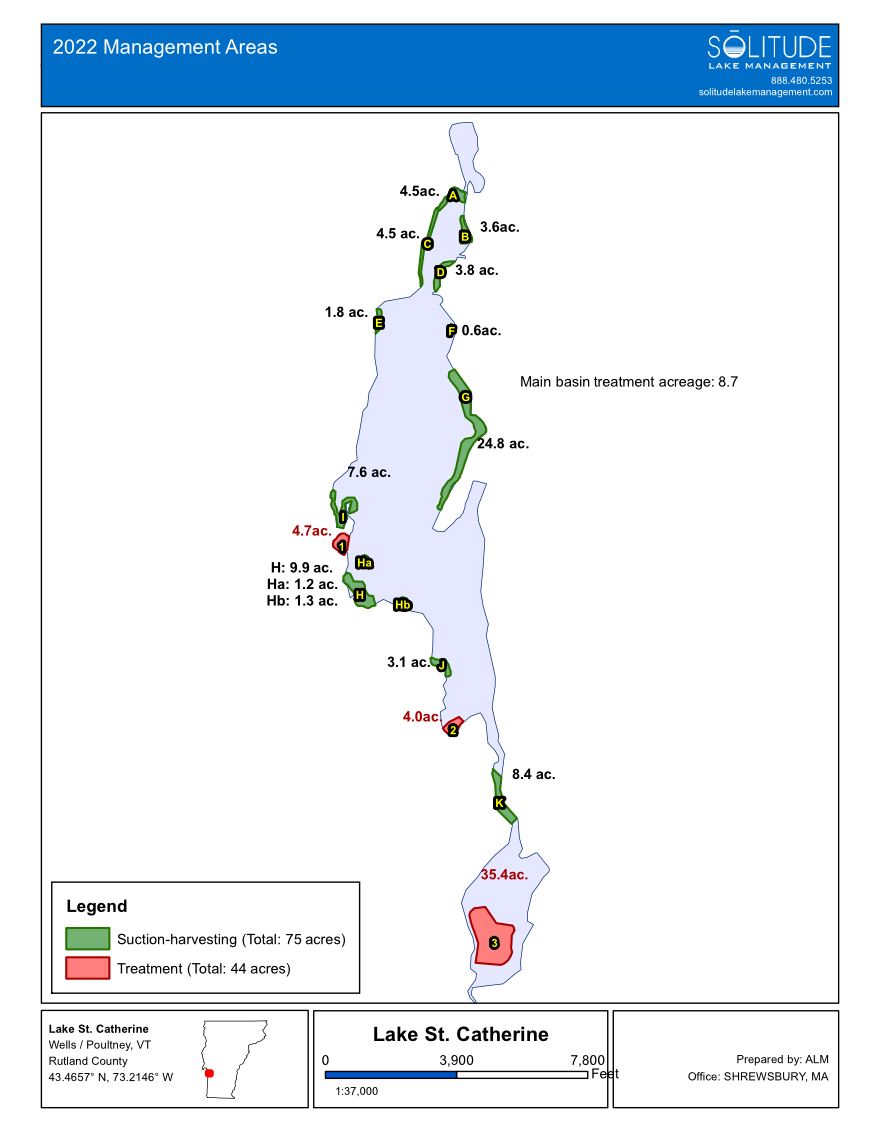
We are happy to report that we have received a $21,910 grant from the Vermont Department Of Environmental Conservation as part of their Aquatic Nuisance Control Grant-In-Aid Program (ANC). Funding for the ANC Grant-in-Aid grants comes from a portion of annual revenues from motorboat registration fees and federal funds.
These funds will help to partially fund both our Greeter Program and our DASH team this season.
> In Summary
The four components of our Milfoil Control Program have been very successful in both keeping the milfoil in check, and in allowing our native aquatic plants to thrive - creating a healthy ecosystem for LSC’s fish and wildlife, and a beautiful lake for all of us to enjoy.
You can read more about the LSCA working on numerous other water quality projects this year, and over the next several years, in our posting: “A Big Year For Lake St. Catherine”. This posting outlines our work on the LSC Stormwater Master Plan, the Lake Wise Program, the LSC Watershed Action Plan, and current and future water testing and measurement programs. These projects are being funded by grants totaling over $100,000, earned from the Lake Champlain Basin Program (LCBP), and will lead to water quality improvements for Lake St. Catherine, and additional clean water funding for future projects.
The LSCA has always employed evidenced-based decision making when evaluating lake related issues, and we continue to do so with our Milfoil Control Program. Working with the State and lake scientists & experts, following the science and the data, and evaluating the results of our efforts show that we are doing the right things for the long-term health of Lake St. Catherine.
To our members, and all who love Lake St. Catherine, if you ever have any questions or concerns, reach out to us. We would be happy to discuss our Milfoil Control Program or any other lake related topic with you so we can address your questions or concerns, and provide you with factual information. Or contact us, and we’ll set up a Dockside Chat, and a LSCA Trustee will swing by your dock for a chat about the lake.
You can always reach us at info@lakestcatherine.org.
We hope you all have a wonderful summer at the lake!
Thank you for your support of the LSCA.